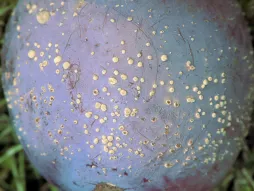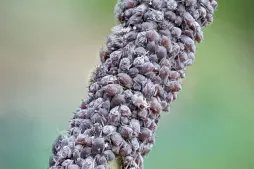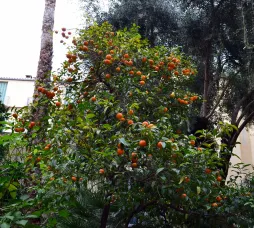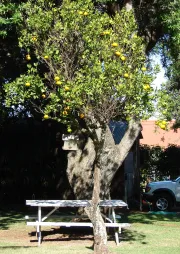Calamondin, the indoor orange tree
Need a bit of luck or color in your life? Grow a Citrus x microcarpa. Known as the calamondin, this citrus fruit from the Rutaceae family is a cross between the kumquat and mandarin tree (Citrus reticulata). In China and many other Asian countries, its round, colorful fruit is believed to bring prosperity.
How to recognize the calamondin, Citrus x microcarpa?
The calamondin is a bushy shrub. In the wild, it reaches heights of two to seven meters. But it doesn't grow taller than one or two meters when grown in pots and indoors.
The short, brown trunk supports spreading branches. The youngest branches are thorny.
The dark-green evergreen leaves are elliptical to obovate. Smooth and glossy, they have slightly crenellated margins. Like Citrus x junos (Citrus junos), calamondin leaves give off a citrus scent when crumpled.
The white flowers are even more fragrant. They have five petals and long stamens. They usually appear in spring.
Fruits are bright yellow or orange, contrasting with the green of the foliage. They resemble a golf ball. Round, they measure barely three centimetres in diameter.
Citrus x microcarpa is non-toxic. You can even eat its fruit, called kalamansi. Provided you appreciate the sweet and sour flavours! While the skin is sweet, the flesh is highly acidic. It's best used in marinades, jams and to flavor dishes and drinks.
Our maintenance tips
Maintaining a Citrus x microcarpa is not difficult. Above all, you need to protect it from frost in winter and provide it with the nutrients it needs to grow. With the right potting soil and regular fertilizing, you'll soon be enjoying your own citrus fruits.
Citrus x microcarpa citrus trees need regular watering all year round. During hot spells, water early in the morning or in the evening. Water evaporates less quickly, and your shrub benefits from it for longer.
Watering
Allow the substrate to dry on the surface (at least three centimetres) between waterings. Water the root ball of your Citrus x microcarpa with non-calcareous water at room temperature.
Don't forget to empty any stagnant water from the dish or pot. It will rot the roots.
Repotting
In spring, transfer your Citrus x microcarpa to a larger pot, so that it can continue to grow.
When roots protrude from the pot or are visible on the surface, it's time to repot!
To prepare your Citrus x microcarpa for repotting, soak the root ball. Then gently loosen the root ball.
Choose a terracotta pot or a wooden tub. Both materials encourage water evaporation and reduce the risk of over-watering. Make sure the container is perforated to allow water to drain away.
At the bottom, place a bed of clay balls or gravel to facilitate drainage.
Top up with a rich substrate, such as special citrus or planting soil. You can make your own mixture with :
- one-third planting soil
- one-third garden soil
- pozzolan.
Place your shrub in the center. The surface of the rootball should be two centimetres below the rim of the pot. Fill with substrate and tamp to eliminate air bubbles. When planting, do not bury the collar.
Fertilization
You can stimulate the development of your plant during its growth phase, in spring and summer, with fertilizer.
Citrus x microcarpa are greedy plants. They need to be fertilized. Feed yours with a special liquid or granulated citrus fertilizer.
Cleaning
Remove dust from foliage with a clean, damp cloth. This will enable your plant to take full advantage of the sunlight.
Prune
Size is not essential. It only helps to control shape and development and improves fruiting. When pruning, always use clean, sharp pruning shears.
Citrus trees flower and fruit on the year's wood. To maintain the compact, rounded shape of your shrub, remove dead branches and shoots growing along the trunk. You can also aerate the center by removing some shoots that have already borne fruit in previous years.
If you want to improve your harvest, you can also carry out a fruiting pruning operation: one month after the appearance of a new shoot, prune it back to a height of 20 centimetres.
Pinch
Pinch your Citrus x microcarpa during its growing season.
To keep your Citrus x microcarpa compact, pinch a bud. You'll create new branches.
Plantation
Once the last spring frosts have passed, you can plant.
Find them a place sheltered from the wind and isolated from other plants. Citrus plants have shallow roots and don't like to share their space.
Dig a hole 70 centimetres wide and 1 metre in diameter. While you're at it, soak the root ball.
Plant the plant in the middle, with the top of the rootball level with the ground. Take care not to bury the collar.
Citrus x microcarpa plants thrive in light, well-drained, rich soil. When filling in, add potting soil or citrus soil to your garden soil. Tamp and water.
Diseases / Threats
Information
| Family | Rutaceae - Rutaceae |
| Type | Citrus - Citrus |
| Species | Calamondin - Citrus x microcarpa |
| Lifecycle | Perennial |
| Foliage | Evergreen |
| Exposures | |
| Substrat | |
| Planting methods |
Open ground In pots In tubs |
| Categories | |
| Tags |
Edible fruit Fritillary |
| Origins |
East Asia Southeast Asia |
| Hardiness (USDA) | 10b |
| Leaf color |
|
| Flower color |
|
| Fruit colors |
|
Discover plants from the same family


























